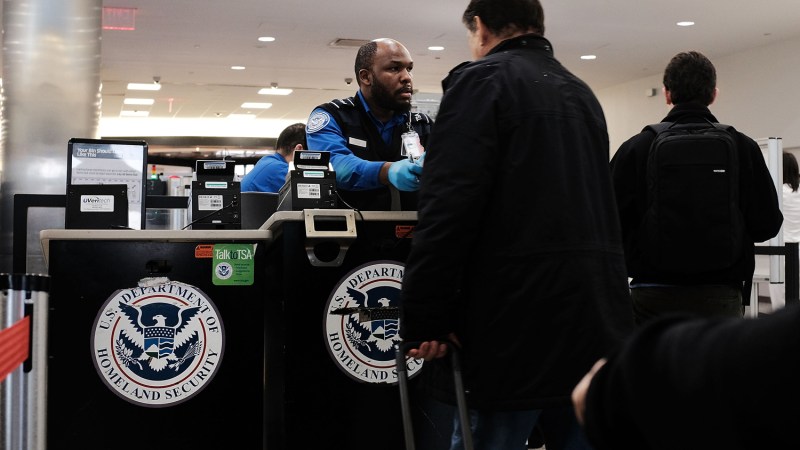Raise your hand if you like waiting in security lines at the airport. What, no one? Well, that’s probably not surprising considering a poll of 2,000 travelers by travel comparison site Cheapflights found waiting in line was Americans’ least favorite part of airport security. That came in ahead of other unpleasantries, such as taking off your shoes and coat and being patted down by TSA personnel.
Even though 31% of those surveyed said long lines were at the top of the list of most dreaded airport security experiences, 54% of those who had flown in the last 90 days reported having been caught in a long security line recently, and 7% had even missed a flight because of it.
Ah, if only there were a way to not have to endure those endless lines. Well, good news: There is! Several programs allow enrollees to skip regular airport security lines in favor of dedicated lines that are usually much shorter. You’ll have to apply, be cleared by the government, and dish out some cash, but if you travel a lot, use major airports where queues tend to be longer, or simply can’t stand being in line for long, the effort might be worth it.
There are four main skip-the-line programs available in the U.S. Four are part of the U.S. Department of Homeland Security’s Trusted Traveler Program, and a private company runs the other.
TSA PreCheck

If you’ve been through airport security in the last few years, you’ve no doubt noticed the signs designating TSA PreCheck lines — perhaps while you were waiting in the much longer regular security line. The program, open to U.S. citizens and lawful permanent residents, allows enrollees to use the dedicated TSA PreCheck lanes at airport security at more than 200 airports, along with bypassing the requirement to remove shoes, belts, and jackets, and removing electronics from carry-on bags. According to the TSA, about 99% of PreCheck passengers wait less than 10 minutes in line.
You can apply for TSA PreCheck online. Once approved, you’ll be asked to make an appointment at one of more than 650 enrollment centers to be fingerprinted, provide ID, and pay the enrollment fee. Once you receive final approval, you’ll get a Known Traveler Number. Add it to your airline reservation and head to the designated line once you’re at airport security. Children under 12 can also use the TSA PreCheck line when traveling with a parent or guardian without enrolling in the program, so it’s a great choice if you travel a lot with kids. The cost for new enrollment is $78 and is good for five years. After that, it’s $70 for five-year renewals.
NEXUS

This U.S. Customs and Border Protection program allows U.S. citizens, permanent residents, and Canadian citizens to use TSA PreCheck expedited security lanes at U.S. airports. NEXUS enrollees can also use Global Entry kiosks when entering the U.S. via Canadian Preclearance airports. If you’re enrolled in NEXUS, you can also use designated expedited lanes at vehicle and pedestrian crossings in the U.S. and Canada. Canadian permanent residents and Mexican nationals can apply for NEXUS to use at these crossings, but they aren’t permitted to use it for TSA PreCheck at airports.
The enrollment process is similar to TSA PreCheck: You apply online, and if initially approved, you’ll make an appointment at a NEXUS enrollment center for an in-person interview and fingerprinting. Once you receive final approval, you’ll get a Known Traveler Number to add to airline reservations. While children under 12 can use TSA PreCheck at airports when traveling with a NEXUS-enrolled parent or guardian, they cannot use expedited lanes at land borders unless they have their own NEXUS cards. Enrollment and renewal is $120 every five years.
Global Entry

Global Entry is also a U.S. Customs and Border Protection program that allows expedited entry into the U.S. from international destinations for U.S. citizens, lawful permanent residents, and certain foreign nationals via automatic kiosks at select airports. All you need to do is present a passport or U.S. permanent resident card, scan your fingerprints, and complete a customs declaration. Global Entry can also be used at TSA PreCheck in airports and Nexus lanes when crossing into the U.S. by land.
You apply online and then can complete an interview at either an enrollment center or upon arrival into the U.S. At $120 for five years, Global Entry is pricier than TSA PreCheck. However, application processing time can vary. According to U.S. Customs and Border Protection, each applicant must schedule a separate interview. While 80% of applicants are approved within two weeks, some applications can take up to a year or longer to be processed.
SENTRI

SENTRI (Secure Electronic Network for Travelers Rapid Inspection) is the last of the programs run by the Department of Homeland Security. It is open to U.S. citizens, U.S lawful permanent residents, and foreign citizens. While it’s mainly designed to provide expedited vehicle and pedestrian crossings into the U.S. from Canada and Mexico, it does provide some benefits at the airport, as it allows access to TSA PreCheck security lines at U.S. airports for U.S. citizens and U.S. lawful permanent residents. Travelers from other countries would have to separately apply to Global Entry to get those benefits.
The cost of SENTRI is $120 for five years, the same as Global Entry and NEXUS. The application process is similar to the other programs: Fill out an application and get conditional approval pending an in-person interview. As with Global Entry, there are potentially long processing times for applications that need manual review, which could take between 12 and 24 months, according to the Department of Homeland Security.
CLEAR

Unlike the other three programs, the U.S. government does not run CLEAR, it is run by a privately owned company certified by the Department of Homeland Security. It allows for a quicker airport identification process at security. Instead of verifying identity by handing documents to security personnel, enrollees verify their identity at kiosks using eye or fingerprint biometrics. However, you’ll still need to go through the regular security line after that and remove your shoes, belt, jacket, and electronics from your carry-ons.
At $199 annually, CLEAR is not cheap, and identity-verifying kiosks are currently only available at 58 U.S. airports. You can apply and complete your biometric scanning at any airport that uses CLEAR or apply online, then complete your scanning at the airport. Although there are other perks, such as allowing you to check into hotels or car rental companies that participate in the service, CLEAR is the most limited and costly of all the skip-the-line programs.
No matter your needs or budget, there’s likely an expedited airport security program that will allow you to avoid long security lineups — not to mention lower your stress level a notch or two the next time you travel.




